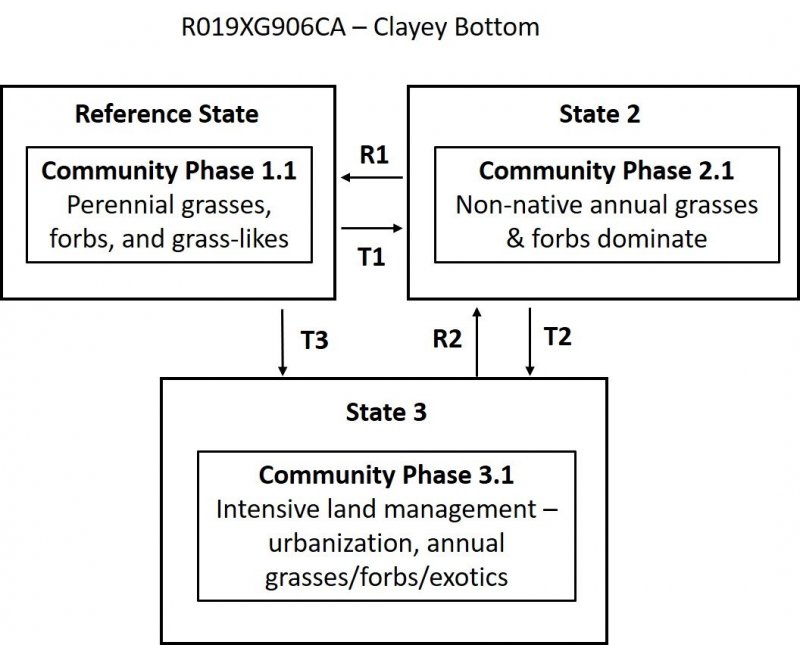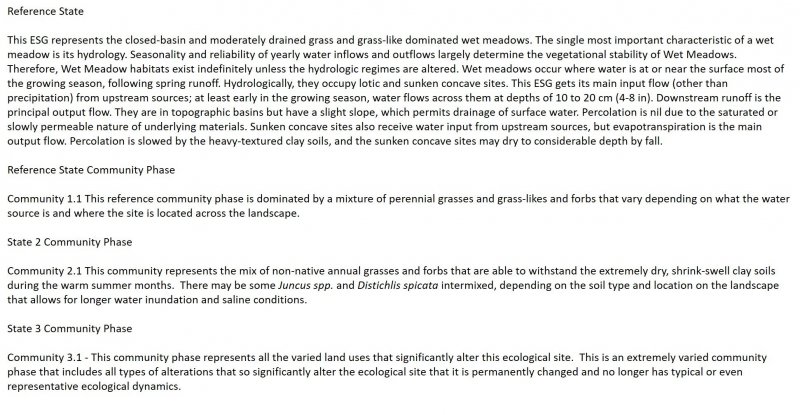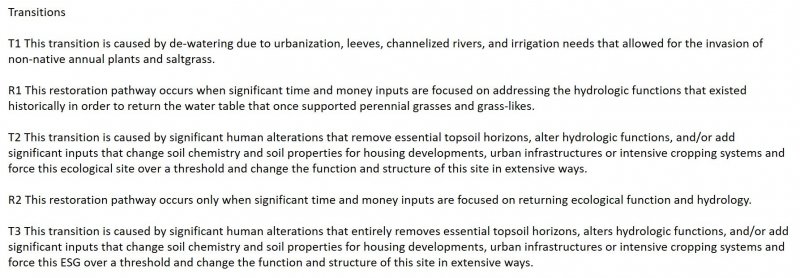Ecological site group R019XG906CA
Clayey Bottom
Last updated: 07/06/2023
Accessed: 12/21/2025
Ecological site group description
Key Characteristics
- located on basin floors
- clayey texture
Provisional. A provisional ecological site description has undergone quality control and quality assurance review. It contains a working state and transition model and enough information to identify the ecological site.
Physiography
This ESG is associated with basins, depressions, and floodplains where water and fine sediments are often deposited with slopes ranging from 0 to 2 percent at elevations from 10 to 2000 feet.
Climate
The average annual precipitation covers a diverse landscape within the MLRA of valleys and mountains and can range anywhere from 8 to 53 inches (215 to 1,354 millimeters), increasing with elevation. Most of the rainfall occurs as low- or moderate-intensity, Pacific frontal storms during winter. Rain can turn to snow at the higher elevations. A little snow may fall in winter, but it does not last. Summers are dry, but fog provides some moisture along the coast. The average annual temperature is 38 to 67 degrees F (3 to 19 degrees C). The freeze-free period averages 310 days in the valleys, 245 days in the mountains, and ranges from 125 to 365 days along the coast. It decreases in length with elevation. The longest freeze-free period occurs at the lower elevations along the western edge of the area.The mean annual precipitation for this ESG is about 16 inches and the mean annual temperature is about 60 degrees F.
Soil features
The soils associated with this ESG consist of mainly very deep, moderately well and well drained clayey soils that have slickensides and formed in alluvium from mixed rock sources. They are found on floodplains, terraces, and in small basins.
The soils that represent this ESG, are the Cropley clay soil, which is a fine, smectitic, thermic Aridic Haploxerert; and the Omni silty clay soil, which is a fine, smectitic, calcareous, thermic Fluvaquentic Endoaquoll.
Vegetation dynamics
This ESG covers the areas of the valleys in MLRA 19 that were at one time part of a vast complex of marshes, tidal flats, estuaries, wetlands and wet meadows. The urbanized landscape in the valleys within this MLRA that exists today makes it difficult to imagine the natural landscape prior to human development.
These clayey bottoms were likely the fine-textured depressional and deposition areas and isolated oxbows that were created from the network of freshwater and salt marshes, rivers and streams that ran through these valleys as their seasonal and tidally influenced flood waters stretched across the floodplains and terraces in spring and deposited sediment as they receded during summer. Once the area began to be settled, many of these water dominated ecosystems were drained, leveed, cleared for crops and other agriculture, and urbanized.
As this landscape was de-watered and houses and agriculture took over, the water table for many of these habitats moved deeper and deeper, creating soils that would no longer offer the available soil moisture for many of the plants that had evolved with the hydrologic function of the natural system that no longer existed. These clayey basins may have remained wetter than many of the surrounding soils, due to their high water-holding capacity and their depressional location on the landscape. The clays of this ESG are high shrink-swell clays that dry out in the summer when the water table recedes and develop cracks and low soil pores spaces making them less hospitable for many of the native perennial grasses that existed within the drier surrounding grasslands.
Historically, this site may have looked similar to the CWHR wet meadow classification, however with the introduction of non-native annual grasses and the impacts from fragmentation, continued de-watering, and human alterations such as homes and roads, this site now reflects a lower producing, dry, annual grassland.
Major Land Resource Area
MLRA 019X
Southern California Coastal Plains and Mountains
Subclasses
Correlated Map Unit Components
23481969, 23477372, 23477373, 23477377, 23477381, 23236808, 22665863, 22665867, 22666823, 22666826, 22644182, 22644214, 22643265, 22644215, 22644110, 22644111
Stage
Provisional
Contributors
Curtis Talbot
Click on box and path labels to scroll to the respective text.


